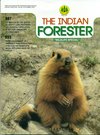Ecology of Indian Crested Porcupine (Hystrix indica) in and around Jodhpur, Rajasthan
DOI:
https://doi.org/10.36808/if/2018/v144i10/139582Keywords:
Thar Desert, Indian Crested Porcupine, Activity, and BehaviorAbstract
Western Rajasthan is the mixture of an arid and semi-arid region, which has a huge desert called 'The Great Indian Thar desert'. It is rich in biodiversity and comprises many unique endemic species. Indian crested porcupine is monogamous species, which is nocturnal and herbivore. The study area of the porcupine is unique and it is present in west part of Jodhpur city. Our study areas included 'Bhooteshwar Van Khand' (Forest area), outside west part of Jodhpur city wall lies in a semi-arid region where different behavior (burrow, feeding, breeding etc) and other activity of ICP were studied. During the study, it is found that change in behavior and activity of porcupine is mainly due to anthropological factor, which makes them survive in this conditions. Road accident and predation by dogs are the major threat to their population in this area. Detail study is needed to study the effect of food preference habit and interspecific interaction with the human.References
Bhupathy S. and Haque M.H. (1986). Association of rock python (Python molurus) with porcupine (Hystrix indica). J. Bombay Natural Hist. Soc., 83: 449-450.
Bhupathy S. and Ramesh C. (2010). Ecology of the endangered Indian rock python, Python molurus in Keoladeo National Park, Bharatpur, Rajasthan, India. Final report was submitted to Ministry of Environment and Forests, Government of India.
Gutterman Y. (1982). Observations on the feeding habit of the Indian crested porcupine (Hystrix indica) and the distribution of some hemicryptophytes and geophytes in the Negev desert highlands. J. Arid. Environ., 5: 61-268.
Gutterman, Y. and Herr, N. (1981). Influence of porcupine (Hystrix indica) on the slopes of the northern Negev mountainsgermination and vegetation renewal in different geomorphological types and slope directions. Oecologia, 51: 332-334.
Idris M., Singh P. and Johari S. (2009). Impact assessment of the Indira Gandhi Canal on the Avifauna of the Thar Desert. Faunal Ecology and Conservation of the Great Indian Thar Desert, Springer, 119-135pp.
Lal D., Sharma G. and Rajpurohit L.S. (2016). Status and Ecobehaviour study of Golden Jackal (Canis aureus) in South Western Rajasthan (India). J. Global Biosciences, 5(5):p 40984104.
Prater, S.H. (2014). The Book of Indian Animals. 12th Ed. Bombay Natural History Society, Bombay, 266-67pp.
Snyder, M.A., and Linhart, Y. B. (1997). Porcupine feeding patterns; selectivity by a generalist herbivore? Can. J. Zool., 75: 2107-2111.
Taber R.D., Sheri A.N. and Ahmad M.S. (1967). Mammals of the Lyallpur region. West Pakistan. J. Mammal, 48: 392-407.
Downloads
Downloads
Published
How to Cite
Issue
Section
License
Unless otherwise stated, copyright or similar rights in all materials presented on the site, including graphical images, are owned by Indian Forester.





